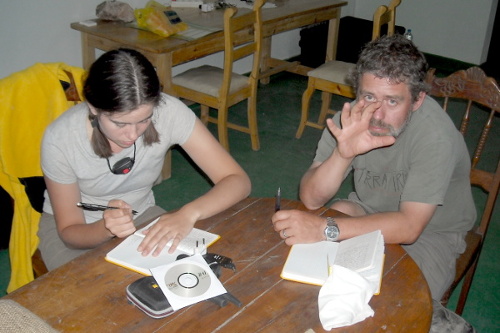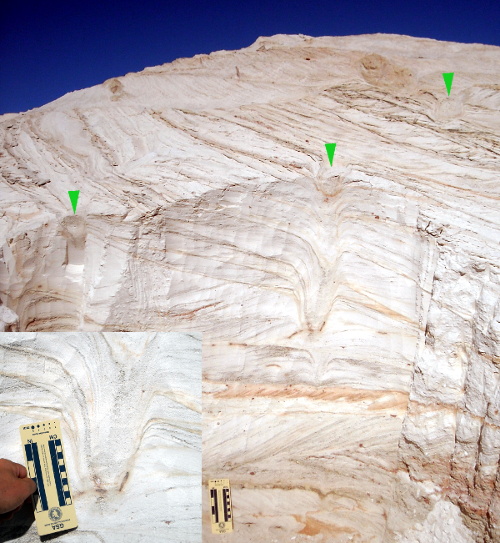Fishing Without a Fossil (Part 2)
Our thrilling conclusion to a 70 million year old mystery in Madagascar. . .if you haven’t already, make sure to read Part 1 for more detailed information!
Lungfish are cool critters. . .they’re hardy fish that are well-adapted to harsh environments and have massive tooth plates that fossilize readily. We know from these abundant fossils that lungfish lived in Madagascar perhaps around 85 million years ago, but there’s no sign of any tooth plates or bones by 70 million years ago, even though the environment was seemingly perfect.
Let me correct that statement. . .there’s no sign of lungfish bones or teeth, but there are traces of lungfish. This highlights an important distinction from the last post–body fossils (such as bones) and trace fossils (tracks, burrows, and other leavings). Body fossils are great for precise identifications, but trace fossils often only allow the most general of identifications. It turns out, though, that lungfish are a merciful exception to this generality–their burrows are pretty darned distinct!
Setting the stage for all of this, joint expeditions in Madagascar with my alma mater Stony Brook University and the University of Antananarivo have uncovered a rich trove of fossils from the end of the Age of Dinosaurs. Paleontologists there have focused on abundant bones of dinosaurs, birds, crocodiles, frogs, and more. But, these body fossils are only part of the story. In order to reconstruct ancient Madagascar in the most thorough detail, geologists also had to get involved.
Enter Ray Rogers, head geologist for the Mahajanga Basin Project and professor at Macalaster College. Ray is a master scientist, perhaps best known in paleontological circles for his work interpreting how dinosaur bones accumulate in drought and other harsh conditions. He is the sort of person who can “read” the sandstones and mudstones housing fossils, assembling the subtle clues that flesh out a past environment. Ray is also a master educator. Some of my fondest memories in Madagascar are those days I have tagged along with Ray, soaking in his lessons on how fluids and sediments interact to produce intricate layers of rocks. His excitement is infectious (and it’s coupled with a ridiculous sense of humor…any work with Ray is guaranteed to be accompanied by good-natured ribbing)! As part of the educational process, Ray engages many undergraduate students from Macalaster in fieldwork. These students are more than just field assistants, but really are given the lead (and take the lead) in research.
Back in 2010, then-undergraduate Madeline Marshall (now a graduate student at University of Chicago) arrived in Madagascar with a mission: to figure out an odd outcrop of rocks that Ray and colleagues had noticed on a previous expedition. They had suspicions about the nature of these rocks, of course, but needed to do some careful documentation and sampling. If all went well, the project would form the core of Madeline’s senior thesis project.

The rocks in question were within a big, lumpy outcrop of sandstone. At first glance, it wasn’t anything remarkable. . .just rocks that had been eroded in the subtropical elements. But, there were some interesting features. In particular, scores of circular and dumbbell-shaped markings dotted the surface. These were interesting to look at, but could they possibly just be odd weathering structures? The subtropical rains can do funny things to rocks, creating all sorts of surface patterns. Being good geologists, Madeline and Ray dug deeper. Thanks to fairly soft sandstone, they were able to quarry out a face of rock showing cross-sections through the surface markings (photo below). This showed, beyond a doubt, that they were genuine features, and not just weathering.

Madeline identified over 70 of these structures spread across 100 square meters of outcrop–so, they weren’t just a random fluke. Many things can deform soft sediments before they turn to rock (and even after). Dinosaur feet are one option, but the shape of the structures in question just weren’t right. Plant roots were also out of the question, because they leave distinctive branching patterns. Dewatering structures–produced when water is squished out of sand as it is compacted–also weren’t a great match. Based on the way the sandstone layers were curved and deformed, the best explanation was an animal burrow–a type of trace fossil. But what kind of animal?
Several possibilities existed, based on the overall size and shape of the burrows. Crayfish, lungfish, clams, and amphibians were all candidates. But, based on comparisons with modern and fossil burrows for all of these, the field was narrowed down. The burrows were too big for clams, and the wrong shape and size for crayfish or amphibians (and the margins of the burrows were too smooth for the latter two). Beyond process of elimination, pretty much every feature of the burrows and their encasing rock screamed “lungfish trace fossil”…the tubes that turned into dumbbell cross-sections, the size, the spacing, the occurrence in a harshly seasonal prehistoric environment. Lungfish were a logical fit all around.

When times get tough, lungfish estivate. That is, they squirm down into the mud or sand, surround themselves with a nasty mesh of mucus (to slow drying out), and (more or less) go to sleep. The rivers or ponds that they lived in might dry up, but the lungfish happily snoozes until the waters return. Then, they wriggle back out of the burrows and return to doing whatever it is that lungfish do in their spare time. The process of squirming in and out of the sediment produces the distinctive trace fossil that is the signature of lungfish.
The burrows in Madagascar are cool for several reasons. Importantly, they’re the first evidence of lungfish from the latest Cretaceous of that island. This is a fantastic example where trace fossils provide information that isn’t preserved in the bony fossil record! Previously, we simply didn’t envision lungfish in the 70 million year old landscape of Madagascar. Now we can also predict, if there are burrows, that lungfish body fossils will be found at some point…maybe even in the bottom of a burrow. Worldwide, Mesozoic lungfish burrows are scarcely reported (most are from the older Paleozoic, prior to the age of dinosaurs). . .and never before from the southern continents. This is truly an important new occurrence. Finally, lungfish burrows are associated with harshly seasonal environments–this is one more piece of evidence, among many others, for how rough it was in northwestern Madagascar 70 million years ago.
To many people, a lungfish burrow may not be as riveting as a dinosaur skull or crocodile skeleton. But, these squirms and scratches capture the moments in time when a long-gone fish wriggled its way in and out of a drying landscape. Ironically, the supposedly more durable bones and teeth haven’t survived the test of time. Only the sands remain to tell the lungfish’s story.
Citation
Marshall, M. S., and R. R. Rogers. 2012. Lungfish burrows from the Upper Cretaceous Maevarano Formation, Mahajanga Basin, northwestern Madagascar. PALAIOS 27:857–866. DOI: 10.2110/palo.2012.p12-018r [paywalled, unfortunately]
Learn more. . .there’s a great video interview with Madeline at the Macalaster College website.
